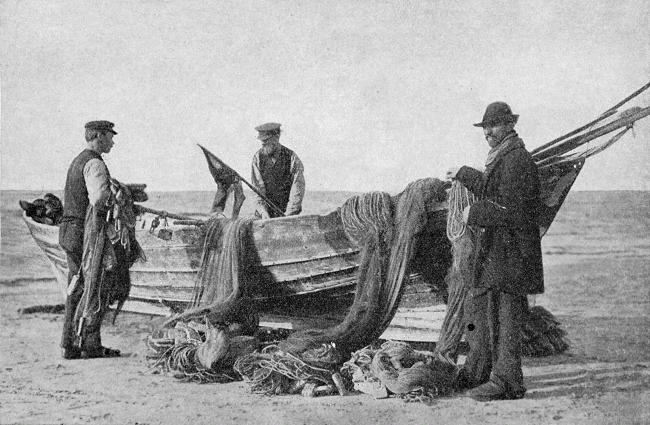
PRESENT-DAY REPRESENTATIVES OF THE ANCIENT SALTS
Although a well-developed industry, fishing no longer forms a chief source of revenue in Latvia. The fishermen were some of the greatest sufferers from the Great War. They were forbidden to continue their trade, thousands were banished from the coast, and confined in concentration camps. But they have now returned to the sea and are toilsomely reviving the industry
Photo, Press Section, Latvian Foreign Office, Riga
These are names which the judges of the art tribunal of Europe cannot overlook. Here, too, mention should be made of the quite remarkable collection of Lettish folksongs (Dainas) that was published several years ago. No fewer than 200,000 original songs go to make up this literary treasure; all creations of unknown poets of the people, who, having sung these inspired songs that were to reverberate through the ages, went their way, uncrowned and unrecognized, to rest in nameless graves. For ethnographers and philologists of Aryan culture, this collection is a priceless storehouse
The Letts are of medium height and sturdily built; they have oval faces, high foreheads, and straight fair hair—a red or black-haired Lett is an uncommon sight.1 They are agriculturists to the finger-tips, having passed most of their existence in peaceful or forced labour on the land, in which all their interests were centred, as their folklore amply testifies. Indeed, Mother Earth has been their only solace from time immemorial. Two of their proverbs: "One need never be ashamed of
| 1 | Dark hair and short noses among Latvians typically reflect mixing with the Livs (Latvian: lībieši), who primarly lived in hamlets along the Baltic sea and Gulf of Riga coastlines, particularly in Kurzeme (Courland). While the Liv culture was still alive—through language and folk song—during Latvia's first period of independence, use of the Liv language and hence the culture has since essentially died out. |
 Gallery
Gallery